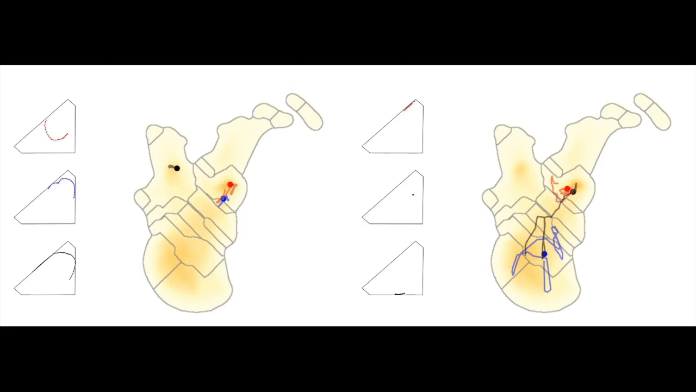Research Topics
High-resolution behavior tracking through ontogeny: new tools for testing theory in behavioral development
How does behavior unfold through development? How do behaviors and experiences dynamically feedback on each other through development? How do patterns of behavioral repertoire diversity and plasticity change through ontogeny - and on what ecological factors does this time course depend? These question can be empirically addressed in unprecedented detail now more than ever, thanks to highly temporally resolved behavioral tracking and a suite of 'big data' analytical approaches to parsing insight from large datasets covering substantial periods during development. I focus the power of these tracking technologies to answer questions related to sensitive developmental windows, developmental plasticity, and the development of individuality.
Can't teach an old fish new tricks?
In one recent study, for example, we track 45 genetically identical Amazon mollies (see Amazon molly pic below) continuously from the day of birth through their first four weeks of life and then measure the degree of every individual's behavioral diversity through life. This allows us to test an old intuition: that the degree of behavioral plasticity decreases as an individual ages. By applying analytical tools that allow us to retain high dimensionality in the data (rather than measuring single axes of behavioral diversity in, say), we calculate individuals' behavioral diversity scores as a measure of their whole-repertoire behavior entropy:

(a) low behavioral entropy (b) high behavioral entropy
Figure. Three 'low behavioral entropy' individuals (a) and 'high behavioral entropy' individual (b) projected simultaneously in physical tank space (triangles to left) and behavioral phenotype space projected in two dimensions (right). Low entropy individuals show more rigid, less diverse behavioral repertoires than high entropy individuals, which show much more behavioral diversity. To the right, we can see that entropy for all 45 individuals shows an inverted U-shape trend, increase during the first two weeks of life before then decreasing in later development.


For a more general overview of how these tools can be used to address fundamental theory in behavioral development, see our recent review in Proceedings of the Royal Society B: "Leveraging big data to uncover the eco-evolutionary factors governing behavioral development"
Integrating development into theory on behavioral individuality
A biologically realistic and predictively powerful theory of behavioral individuality requires developmentally explicit models. Including features of development in evolutionary models improves their explanatory power and brings these models into closer alignment with empirically observed patterns.
I'm currently involved with a number of projects that seek to incorporate important features of development (i.e., explicit time, path dependencies, developmental trade-offs, etc.) into models of behavioral individuality. These projects use as a basis a number of well-known mechanisms for creating or maintaining adaptive individuality within populations (behavior-state feedbacks, biological trade-offs, negative frequency dependence, social niche specialization), and then ask how patterns of individuality emerge through development when features of development are added to these basic models.
In one recent model, for example, I identified general ecological scenarios in which we might expect for behavior-state feedbacks throughout development to lead to increasing behavioral individuality throughout development (i.e., positive feedbacks) vs. behavioral convergence through development (i.e., negative feedbacks).


C
Figure. Developmental phenotypes spaces where individuals begin life at the apex of each graph and then 'move through' phenotype space, downwards, through development as they hone their phenotypes. Negative state-behavior feedbacks create populations of relatively similar generalists (A), while positive state-behavior feedbacks create populations of specialists, with a high degree of individuality. It's fun to think about these developmental phenotype spaces like developmental 'Galton boards' (C) - evolution sets the 'pins' in the 'board', creating particular distributions of phenotypes as they developmentally flow through Galton board phenotype space.
For an overview of how incorporating development into evolutionary models can provide additional insight and advance the state of theory see: Snell-Rood EC and Ehlman SM. Developing the genotype-to-phenotype relationship in evolutionary theory: a primer of developmental features.
Explaining variation in behavioral responses to anthropogenic environmental change: the roles of developmental and evolutionary histories
Understanding the evolutionary and developmental sources of behavioral variation may improve our ability to predict behavioral responses to novel environments. I study this in the context of theory and fieldwork in the streams of Trinidad.

Figure. A framework for understanding behavioral responses to novel environments, mediated in part through development. Trains and the systems involved in their development (i.e., 'cue-response systems') are shaped by past environments; the degree to which they are affected by environmental change depends on the match/mismatch between past and novel environments. Adapted from Sih A, Trimmer PC, and Ehlman SM. A conceptual framework for understanding behavioral responses to HIREC.
From a theoretical perspective, I build evolutionary models that predict optimal behavioral rules in ‘natural’, pre-change environments and then ask what the fitness costs are of anthropogenic changes before behaviors have a chance to evolve or plastically adjust. From here, models then accommodate developmental processes such as plasticity, assessing the degree to which development may compensate for a lack of previous experience with novel environments. My colleagues and I have explored this framework to produce insights in contexts ranging from predator prey-interactions, novel resources, habitat alterations, and susceptibility of animals to evolutionary traps...but there's much more to do!
My empirical work in this area focuses on understanding variation in behavioral responses of the Trinidadian guppy to salient environmental changes in the Trinidad Northern Range Mountains, namely deforestation and rock quarrying, resulting in dramatically altered stream environments. Additionally, some streams also harbor novel predators, such as tilapia from local aquaculture activities. This system is well known in ecology and evolution since populations of guppies are locally adapted to particular predation regimes, with some 'low predation' populations differing dramatically in behavior, life history, diet choice, and mate choice compared to their 'high predation' counterparts. I leverage the wealth of natural history knowledge in this system to ask how populations with different evolutionary histories respond to novel environmental conditions, and whether development has a role to play in mediating these divergent responses.
